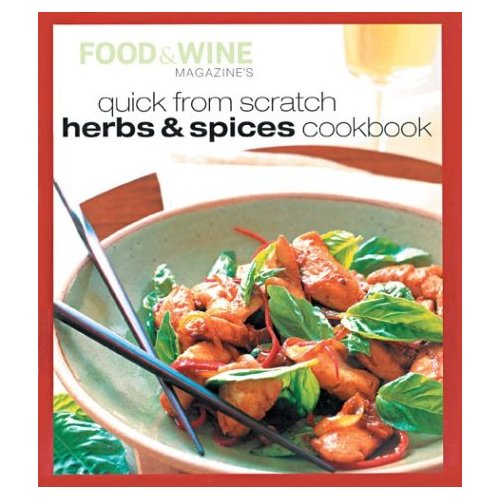Cookbook Review: Quick From Scratch Herbs and Spices Cookbook
Cookbooks. I walk out of Ed’s Editions with them all but clinging to my sleeves like burrs. There is a stack of them by my bed that act as a dam against long nursing sessions. Leaving the library I generally have a stack of touch-n-feel board books under one arm and cookbooks under the other.
And yet, I rarely use these books in the kitchen. I either head into the kitchen in the buff recipewise or do a quick interweb search of my favorite blogs. My collection of cookbooks are more like shelf candy than useful tools. They proclaim to everyone who enters my kitchen that “Here is a person who likes to cook!” In an effort to get to know my cookbooks as more than decorations, I have been adopting one book a month as my fount of inspiration. I make an effort to read through it, absorb it’s lessons, and of course cook from it.
January meals were sponsored by the Quick from Scratch Herbs and Spices Cookbook published by Food and Wine magazine.
 I had many moments of déjà vu while using this book. I bought it years ago when I first started cooking (or wanting to cook). It came from one of those piles of Reduced! books at Barnes and Noble. Though now I’d probably pass it up for one of the “real” cookbooks from the shelves, it was my golden ticket back then; just what I needed to imagine my way out of culinary poverty.
I had many moments of déjà vu while using this book. I bought it years ago when I first started cooking (or wanting to cook). It came from one of those piles of Reduced! books at Barnes and Noble. Though now I’d probably pass it up for one of the “real” cookbooks from the shelves, it was my golden ticket back then; just what I needed to imagine my way out of culinary poverty.
Each herb or spice gets a brief introduction detailing its flavor profile (spicy, floral, ect), a bit of its history, and the types of dishes it is used in. The introduction is followed by two or three recipes highlighting that herb. I read these introductions with the voracity of an English major. The spices became characters in my mind, each with their own motivations, attachments, and aversions. I learned, for example, that coriander is the child of cilantro. Once cilantro flowers, it produces tiny little seeds- that’s coriander. While this kind of knowledge is common place to me now, it was cutting edge to me then, as if I’d figured out a secret symbol in a novel that raised the book from mediocre to sublime.
Overall, this is a wonderful book for someone who still memorizing the difference between a spatula and a whisk or is looking to graduate from packet’n'can cooking. The ingredient lists all start with raw, real food. Not a Pillsbury dough can or microwave in sight. Yet, most of the time, the recipes are not so complicated so as to be intimidating.
One caution I’d like to make plain, however, is that “quick” rarely resides with “cheap.” Especially when it comes to meat cookery (of which there is a lot in this book), you will pay for the convenience of being able to cook your meal in ten minutes. Which, perhaps, is what the beginner needs: near instant results. Once you are more comfortable in the kitchen though, just remember there is a better way to make stew than with steak.
While I have now cooked long enough to be able to picture what a dish will look like in my head, back then I was quite dependent on pictures to explicate the recipe. What, exactly, did it mean to cut the roast across the grain? Or what should a properly segmented orange look like? This book was illuminating in that regard. Each recipe takes an entire spread. So on one page you have the written recipe while the facing page is a full color picture of the finished dish. While my finished dishes rarely looked like the pictures, it gave me a goal. Rather like being given directions to an unfamiliar location with both street names and landmarks.
Perhaps the biggest impact this book had on my early cooking was to give me the confidence to experiment with herbs and spices. If they could put black pepper in a strawberry dessert, why couldn’t I add cinnamon to chili? And that experimentation, more than anything else, is at the heart of my cooking even still.

